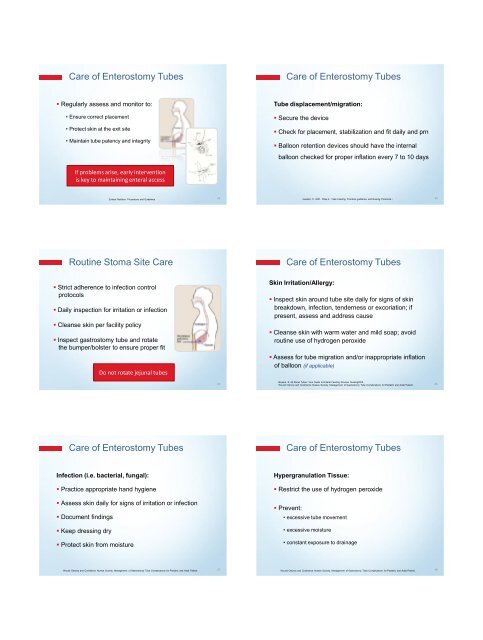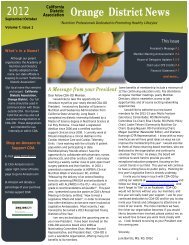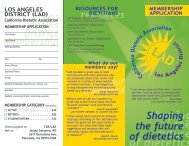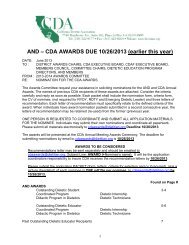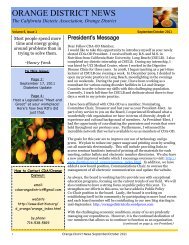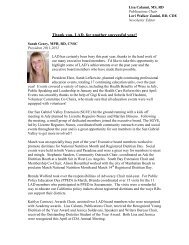The Selection and Care of Enteral Feeding Tubes
The Selection and Care of Enteral Feeding Tubes
The Selection and Care of Enteral Feeding Tubes
You also want an ePaper? Increase the reach of your titles
YUMPU automatically turns print PDFs into web optimized ePapers that Google loves.
<strong>Care</strong> <strong>of</strong> Enterostomy <strong>Tubes</strong><br />
Regularly assess <strong>and</strong> monitor to:<br />
• Ensure correct placement<br />
• Protect skin at the exit site<br />
• Maintain tube patency <strong>and</strong> integrity<br />
If problems arise, early intervention<br />
is key to maintaining enteral access<br />
<strong>Enteral</strong> Nutrition: Procedures <strong>and</strong> Guidelines<br />
Routine Stoma Site <strong>Care</strong><br />
Strict adherence to infection control<br />
protocols<br />
Daily inspection for irritation or infection<br />
Cleanse skin per facility policy<br />
Inspect gastrostomy tube <strong>and</strong> rotate<br />
the bumper/bolster to ensure proper fit<br />
Do not rotate jejunal tubes<br />
<strong>Care</strong> <strong>of</strong> Enterostomy <strong>Tubes</strong><br />
Infection (i.e. bacterial, fungal):<br />
Practice appropriate h<strong>and</strong> hygiene<br />
Assess skin daily for signs <strong>of</strong> irritation or infection<br />
Document findings<br />
Keep dressing dry<br />
Protect skin from moisture<br />
Wound Ostomy <strong>and</strong> Continence Nurses Society, Management <strong>of</strong> Gastrostomy Tube Complications for Pediatric <strong>and</strong> Adult Patient.<br />
43<br />
45<br />
47<br />
<strong>Care</strong> <strong>of</strong> Enterostomy <strong>Tubes</strong><br />
Tube displacement/migration:<br />
Secure the device<br />
Check for placement, stabilization <strong>and</strong> fit daily <strong>and</strong> prn<br />
Balloon retention devices should have the internal<br />
balloon checked for proper inflation every 7 to 10 days<br />
Guenter, P. 2001. Chap 4. Tube <strong>Feeding</strong>: Practical guidelines <strong>and</strong> Nursing Protocols..;<br />
<strong>Care</strong> <strong>of</strong> Enterostomy <strong>Tubes</strong><br />
Skin Irritation/Allergy:<br />
Inspect skin around tube site daily for signs <strong>of</strong> skin<br />
breakdown, infection, tenderness or excoriation; if<br />
present, assess <strong>and</strong> address cause<br />
Cleanse skin with warm water <strong>and</strong> mild soap; avoid<br />
routine use <strong>of</strong> hydrogen peroxide<br />
Assess for tube migration <strong>and</strong>/or inappropriate inflation<br />
<strong>of</strong> balloon (if applicable)<br />
Bowers, S. All About <strong>Tubes</strong>: Your Guide to <strong>Enteral</strong> <strong>Feeding</strong> Devices. Nursing2000.<br />
Wound Ostomy <strong>and</strong> Continence Nurses Society, Management <strong>of</strong> Gastrostomy Tube Complications for Pediatric <strong>and</strong> Adult Patient.<br />
<strong>Care</strong> <strong>of</strong> Enterostomy <strong>Tubes</strong><br />
Hypergranulation Tissue:<br />
Restrict the use <strong>of</strong> hydrogen peroxide<br />
Prevent:<br />
• excessive tube movement<br />
• excessive moisture<br />
• constant exposure to drainage<br />
Wound Ostomy <strong>and</strong> Continence Nurses Society, Management <strong>of</strong> Gastrostomy Tube Complications for Pediatric <strong>and</strong> Adult Patient.<br />
44<br />
46<br />
48


